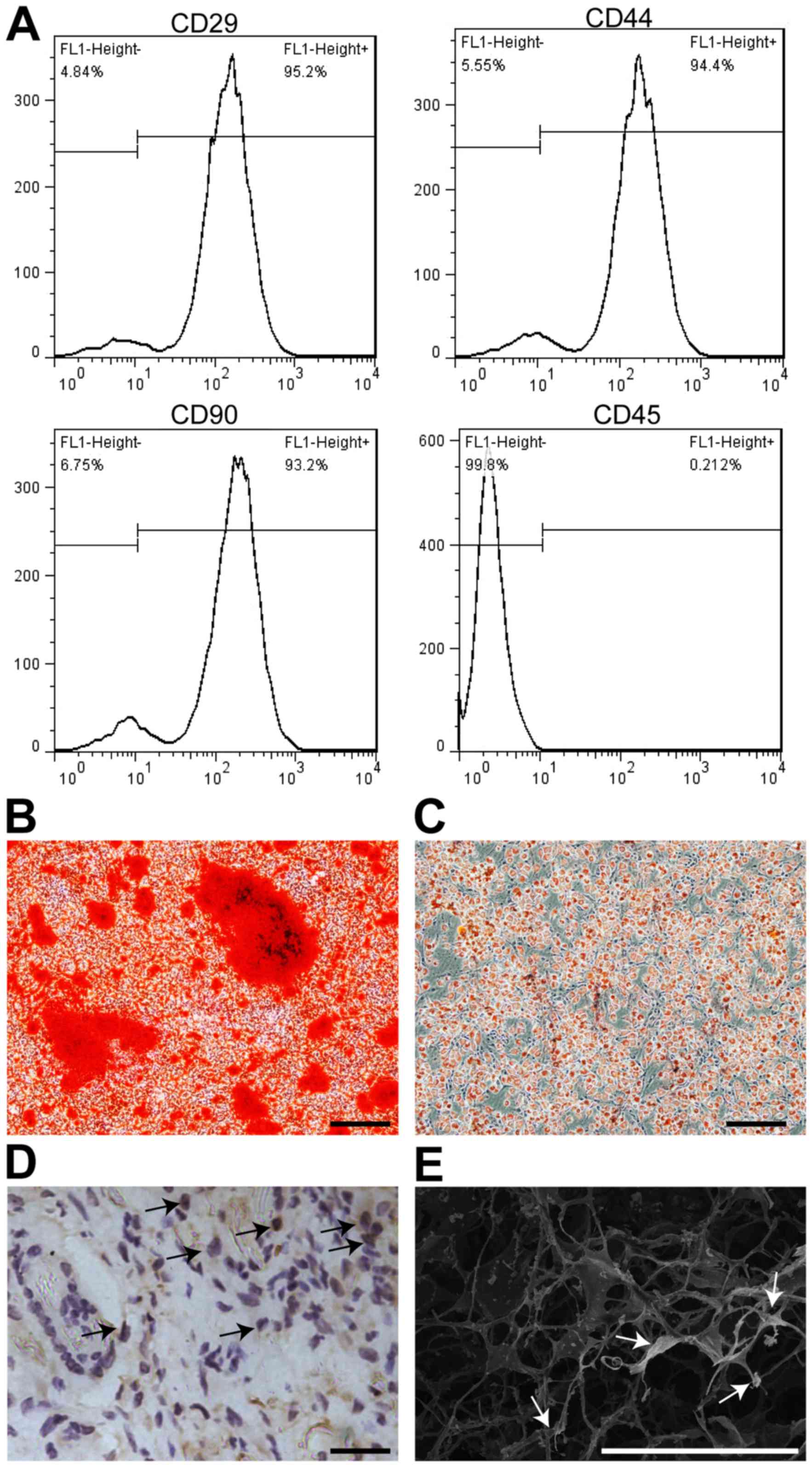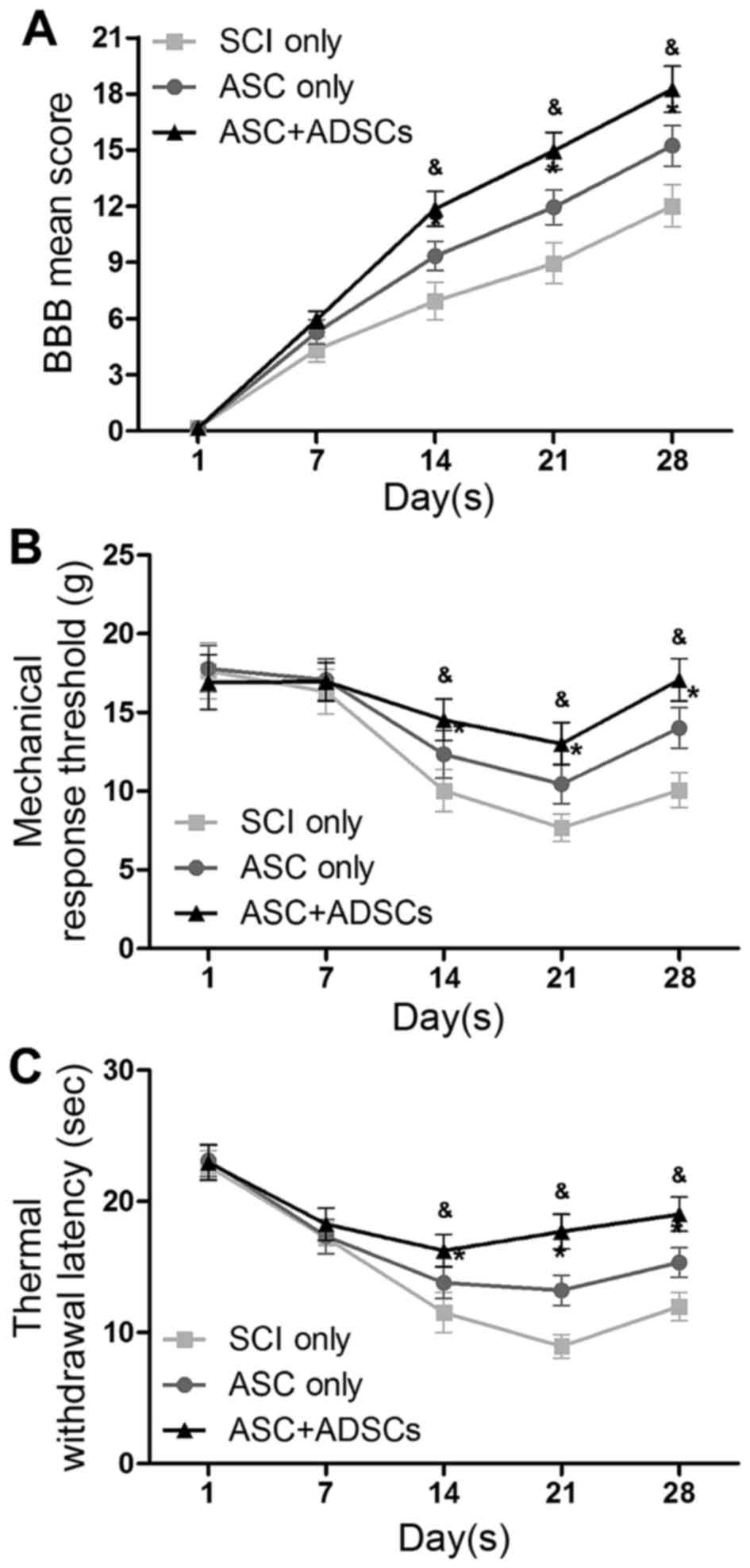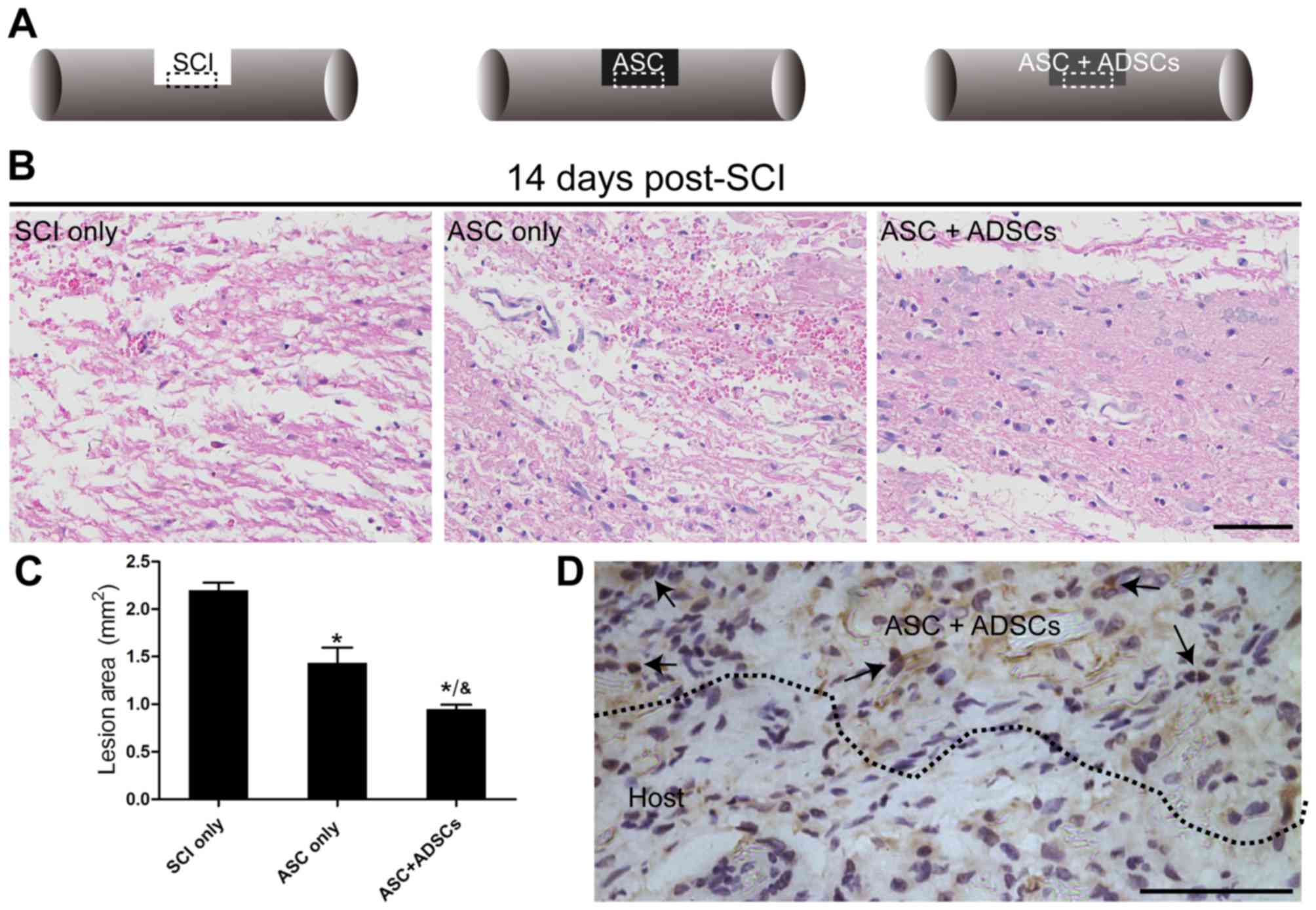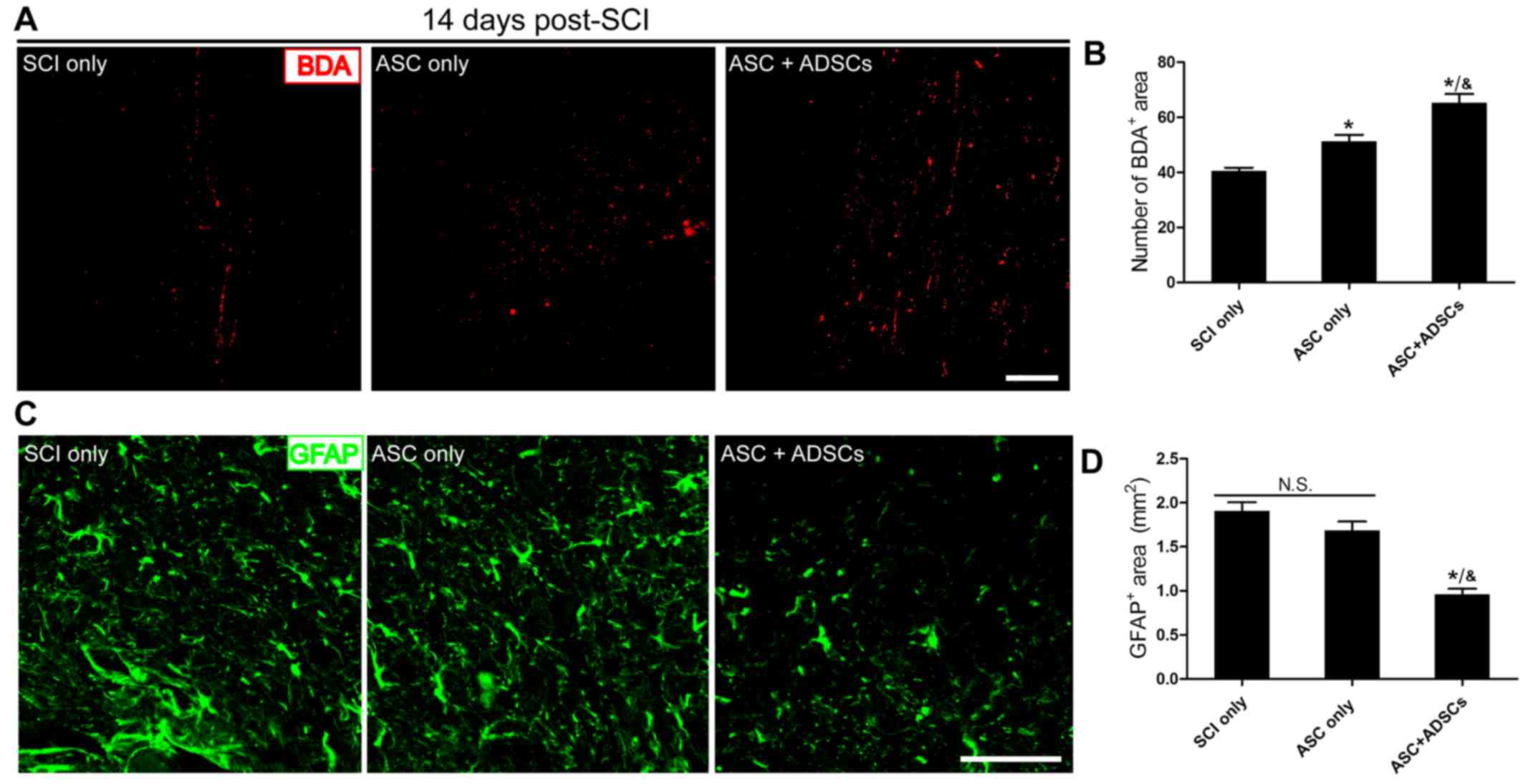|
1
|
Selvarajah S, Hammond ER and Schneider EB:
Trends in traumatic spinal cord injury. Jama. 314:16432015.
View Article : Google Scholar : PubMed/NCBI
|
|
2
|
Rubiano AM, Carney N, Chesnut R and Puyana
JC: Global neurotrauma research challenges and opportunities.
Nature. 527 Suppl:S193–S197. 2015. View Article : Google Scholar : PubMed/NCBI
|
|
3
|
Requejo-Aguilar R, Alastrue-Agudo A,
Cases-Villar M, Lopez-Mocholi E, England R, Vicent MJ and
Moreno-Manzano V: Combined polymer-curcumin conjugate and ependymal
progenitor/stem cell treatment enhances spinal cord injury
functional recovery. Biomaterials. 113:18–30. 2017. View Article : Google Scholar : PubMed/NCBI
|
|
4
|
Ban DX, Liu Y, Cao TW, Gao SJ and Feng SQ:
The preparation of rat's acellular spinal cord scaffold and
co-culture with rat's spinal cord neuron in vitro. Spinal cord.
55:411–418. 2017. View Article : Google Scholar : PubMed/NCBI
|
|
5
|
Uchida S, Hayakawa K, Ogata T, Tanaka S,
Kataoka K and Itaka K: Treatment of spinal cord injury by an
advanced cell transplantation technology using brain-derived
neurotrophic factor-transfected mesenchymal stem cell spheroids.
Biomaterials. 109:1–11. 2016. View Article : Google Scholar : PubMed/NCBI
|
|
6
|
Guo SZ, Ren XJ, Wu B and Jiang T:
Preparation of the acellular scaffold of the spinal cord and the
study of biocompatibility. Spinal Cord. 48:576–581. 2010.
View Article : Google Scholar : PubMed/NCBI
|
|
7
|
Jiang T, Ren XJ, Tang JL, Yin H, Wang KJ
and Zhou CL: Preparation and characterization of
genipin-crosslinked rat acellular spinal cord scaffolds. Mater Sci
Eng C Mater Biol Appl. 33:3514–3521. 2013. View Article : Google Scholar : PubMed/NCBI
|
|
8
|
Liu J, Chen J, Liu B, Yang C, Xie D, Zheng
X, Xu S, Chen T, Wang L, Zhang Z, et al: Acellular spinal cord
scaffold seeded with mesenchymal stem cells promotes long-distance
axon regeneration and functional recovery in spinal cord injured
rats. J Neurol Sci. 325:127–136. 2013. View Article : Google Scholar : PubMed/NCBI
|
|
9
|
Wu SH, Huang SH, Lo YC, Chai CY, Lee SS,
Chang KP, Lin SD, Lai CS, Yeh JL and Kwan AL: Autologous
adipose-derived stem cells attenuate muscular atrophy and protect
spinal cord ventral horn motor neurons in an animal model of burn
injury. Cytotherapy. 17:1066–1075. 2015. View Article : Google Scholar : PubMed/NCBI
|
|
10
|
Lu S, Lu C, Han Q, Li J, Du Z, Liao L and
Zhao RC: Adipose-derived mesenchymal stem cells protect PC12 cells
from glutamate excitotoxicity-induced apoptosis by upregulation of
XIAP through PI3-K/Akt activation. Toxicology. 279:189–195. 2011.
View Article : Google Scholar : PubMed/NCBI
|
|
11
|
Tomita K, Madura T, Sakai Y, Yano K,
Terenghi G and Hosokawa K: Glial differentiation of human
adipose-derived stem cells: Implications for cell-based
transplantation therapy. Neuroscience. 236:55–65. 2013. View Article : Google Scholar : PubMed/NCBI
|
|
12
|
Lukovic D, Stojkovic M, Moreno-Manzano V,
Jendelova P, Sykova E, Bhattacharya SS and Erceg S: Concise review:
Reactive astrocytes and stem cells in spinal cord injury: Good guys
or bad guys? Stem Cells. 33:1036–1041. 2015. View Article : Google Scholar : PubMed/NCBI
|
|
13
|
Kim Y, Jo SH, Kim WH and Kweon OK:
Antioxidant and anti-inflammatory effects of intravenously injected
adipose derived mesenchymal stem cells in dogs with acute spinal
cord injury. Stem Cell Res Ther. 6:2292015. View Article : Google Scholar : PubMed/NCBI
|
|
14
|
Lee HY, Lee HL, Yun Y, Kim JS, Ha Y, Yoon
DH, Lee SH and Shin DA: Human adipose stem cells improve mechanical
allodynia and enhance functional recovery in a rat model of
neuropathic pain. Tissue Eng Part A. 21:2044–2052. 2015. View Article : Google Scholar : PubMed/NCBI
|
|
15
|
Sarveazad A, Babahajian A, Bakhtiari M,
Soleimani M, Behnam B, Yari A, Akbari A, Yousefifard M, Janzadeh A,
Amini N, et al: The combined application of human adipose derived
stem cells and chondroitinase ABC in treatment of a spinal cord
injury model. Neuropeptides. 61:39–47. 2017. View Article : Google Scholar : PubMed/NCBI
|
|
16
|
Ji WC, Zhang XW and Qiu YS: Selected
suitable seed cell, scaffold and growth factor could maximize the
repair effect using tissue engineering method in spinal cord
injury. World J Exp Med. 6:58–62. 2016. View Article : Google Scholar : PubMed/NCBI
|
|
17
|
Komiyama S, Sakakura C, Murayama Y,
Komatsu S, Shiozaki A, Kuriu Y, Ikoma H, Nakanishi M, Ichikawa D,
Hujiwara H, et al: Adipose-derived stem cells enhance tissue
regeneration of gastrotomy closure. J Surg Res. 185:945–952. 2013.
View Article : Google Scholar : PubMed/NCBI
|
|
18
|
Choron RL, Chang S, Khan S, Villalobos MA,
Zhang P, Carpenter JP, Tulenko TN and Liu Y: Paclitaxel impairs
adipose stem cell proliferation and differentiation. J Surg Res.
196:404–415. 2015. View Article : Google Scholar : PubMed/NCBI
|
|
19
|
Basso DM, Beattie MS and Bresnahan JC:
Graded histological and locomotor outcomes after spinal cord
contusion using the NYU weight-drop device versus transection. Exp
Neurol. 139:244–256. 1996. View Article : Google Scholar : PubMed/NCBI
|
|
20
|
Yuan J, Zou M, Xiang X, Zhu H, Chu W, Liu
W, Chen F and Lin J: Curcumin improves neural function after spinal
cord injury by the joint inhibition of the intracellular and
extracellular components of glial scar. J Surg Res. 195:235–245.
2015. View Article : Google Scholar : PubMed/NCBI
|
|
21
|
Hu R, Zhou J, Luo C, Lin J, Wang X, Li X,
Bian X, Li Y, Wan Q, Yu Y and Feng H: Glial scar and
neuroregeneration: Histological, functional and magnetic resonance
imaging analysis in chronic spinal cord injury. J Neurosurg Spine.
13:169–180. 2010. View Article : Google Scholar : PubMed/NCBI
|
|
22
|
Prodromidou K, Papastefanaki F, Sklaviadis
T and Matsas R: Functional cross-talk between the cellular prion
protein and the neural cell adhesion molecule is critical for
neuronal differentiation of neural stem/precursor cells. Stem
Cells. 32:1674–1687. 2014. View Article : Google Scholar : PubMed/NCBI
|
|
23
|
Ide C, Nakano N and Kanekiyo K: Cell
transplantation for the treatment of spinal cord injury-bone marrow
stromal cells and choroid plexus epithelial cells. Neural Regen
Res. 11:1385–1388. 2016. View Article : Google Scholar : PubMed/NCBI
|
|
24
|
Nandoe Tewarie RD, Hurtado A, Levi AD,
Grotenhuis JA and Oudega M: Bone marrow stromal cells for repair of
the spinal cord: Towards clinical application. Cell Transplantat.
15:563–577. 2006. View Article : Google Scholar
|
|
25
|
Frese L, Dijkman PE and Hoerstrup SP:
Adipose tissue-derived stem cells in regenerative medicine.
Transfus Med Hemother. 43:268–274. 2016. View Article : Google Scholar : PubMed/NCBI
|
|
26
|
Bai L, Lennon DP, Eaton V, Maier K, Caplan
AI, Miller SD and Miller RH: Human bone marrow-derived mesenchymal
stem cells induce Th2-polarized immune response and promote
endogenous repair in animal models of multiple sclerosis. Glia.
57:1192–1203. 2009. View Article : Google Scholar : PubMed/NCBI
|
|
27
|
Mazzone GL, Veeraraghavan P,
Gonzalez-Inchauspe C, Nistri A and Uchitel OD: ASIC channel
inhibition enhances excitotoxic neuronal death in an in vitro model
of spinal cord injury. Neuroscience. 343:398–410. 2017. View Article : Google Scholar : PubMed/NCBI
|
|
28
|
Hansen CN, Norden DM, Faw TD, Deibert R,
Wohleb ES, Sheridan JF, Godbout JP and Basso DM: Lumbar myeloid
cell trafficking into locomotor networks after thoracic spinal cord
injury. Exp Neurol. 282:86–98. 2016. View Article : Google Scholar : PubMed/NCBI
|
|
29
|
Anwar MA and Eid AH: Determination of
vascular reactivity of middle cerebral arteries from stroke and
spinal cord injury animal models using pressure myography. Methods
Mol Biol. 1462:611–624. 2016. View Article : Google Scholar : PubMed/NCBI
|
|
30
|
Lee JY, Na WH, Choi HY, Lee KH, Ju BG and
Yune TY: Jmjd3 mediates blood-spinal cord barrier disruption after
spinal cord injury by regulating MMP-3 and MMP-9 expressions.
Neurobiol Dis. 95:66–81. 2016. View Article : Google Scholar : PubMed/NCBI
|
|
31
|
Haan N, Zhu B, Wang J, Wei X and Song B:
Crosstalk between macrophages and astrocytes affects proliferation,
reactive phenotype and inflammatory response, suggesting a role
during reactive gliosis following spinal cord injury. J
Neuroinflammation. 12:1092015. View Article : Google Scholar : PubMed/NCBI
|
|
32
|
Impellizzeri D, Ahmad A, Di Paola R,
Campolo M, Navarra M, Esposito E and Cuzzocrea S: Role of Toll like
receptor 4 signaling pathway in the secondary damage induced by
experimental spinal cord injury. Immunobiology. 220:1039–1049.
2015. View Article : Google Scholar : PubMed/NCBI
|
|
33
|
Ishii T, Ueyama T, Shigyo M, Kohta M,
Kondoh T, Kuboyama T, Uebi T, Hamada T, Gutmann DH, Aiba A, et al:
A novel rac1-gspt1 signaling pathway controls astrogliosis
following central nervous system injury. J Biol Chem.
292:1240–1250. 2017. View Article : Google Scholar : PubMed/NCBI
|
|
34
|
Ruzicka J, Machova-Urdzikova L, Gillick J,
Amemori T, Romanyuk N, Karova K, Zaviskova K, Dubisova J, Kubinova
S, Murali R, et al: A comparative study of three different types of
stem cells for treatment of rat spinal cord injury. Cell
Transplant. 26:585–603. 2017. View Article : Google Scholar : PubMed/NCBI
|
|
35
|
Tang L, Lu X, Zhu R, Qian T, Tao Y, Li K,
Zheng J, Zhao P, Li S, Wang X and Li L: Adipose-derived stem cells
expressing the neurogenin-2 promote functional recovery after
spinal cord injury in rat. Cell Mol Neurobiol. 36:657–667. 2016.
View Article : Google Scholar : PubMed/NCBI
|
|
36
|
Liu XL, Zhang W and Tang SJ: Intracranial
transplantation of human adipose-derived stem cells promotes the
expression of neurotrophic factors and nerve repair in rats of
cerebral ischemia-reperfusion injury. Int J Clin Exp Pathol.
7:174–183. 2014.PubMed/NCBI
|
|
37
|
Menezes K, Nascimento MA, Goncalves JP,
Cruz AS, Lopes DV, Curzio B, Bonamino M, de Menezes JR, Borojevic
R, Rossi MI and Coelho-Sampaio T: Human mesenchymal cells from
adipose tissue deposit laminin and promote regeneration of injured
spinal cord in rats. PloS one. 9:e960202014. View Article : Google Scholar : PubMed/NCBI
|
|
38
|
Yeh DC, Chan TM, Harn HJ, Chiou TW, Chen
HS, Lin ZS and Lin SZ: Adipose tissue-derived stem cells in neural
regenerative medicine. Cell Transplant. 24:487–492. 2015.
View Article : Google Scholar : PubMed/NCBI
|
|
39
|
Yang YC, Liu BS, Shen CC, Lin CH, Chiao MT
and Cheng HC: Transplantation of adipose tissue-derived stem cells
for treatment of focal cerebral ischemia. Curr Neurovasc Res.
8:1–13. 2011. View Article : Google Scholar : PubMed/NCBI
|













